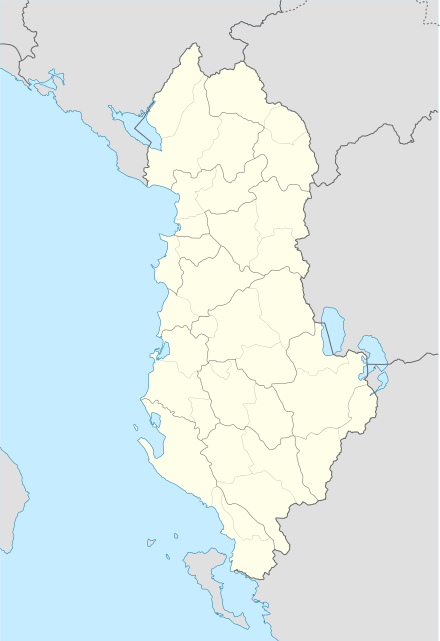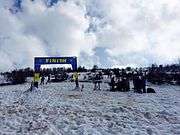Shishtavec
Shishtavec (Cyrillic: Шиштавец) is a village in Kukës County in northeastern Albania. It was also the seat of the former municipality of the same name. At the 2015 local government reform it became part of the municipality Kukës.[1] The administrative unit of Shishtavec contains the villages Borje, Oreshkë, Cërnalevë and Shishtavec which are populated by the Muslim Slavic speaking Gorani people,[2] whereas the villages of Novosej, Kollovoz and Shtrezë are inhabited by Albanians.[3][4]
Shishtavec Шиштавец | |
|---|---|
 Shishtavec | |
| Coordinates: 41°59′N 20°36′E | |
| Country | |
| County | Kukës |
| Municipality | Kukës |
| Municipal unit | Shishtavec |
| Elevation | 1,300 m (4,300 ft) |
| Time zone | UTC+1 (CET) |
| • Summer (DST) | UTC+2 (CEST) |
According to the 2011 census, 68.3% of the municipality identified ethnically as Albanian, while 7.7% identified as Macedonian. The remainder did not declare an ethnicity.[5]
The Gorani population in Albania identifies itself mostly with the Albanians, unlike the Gorani inhabitants of Kosovo and North Macedonia. There are recent attempts to recognize them as forming their own minority group, as with others who identify with Bulgaria, Serbia, and North Macedonia.
Village of Shishtavec
The village of Shishtavec consists of around 300 households with over 1,800 Gorani inhabitants. The area is part of the wider Gora region, most of it lies in the other side of the border in modern Kosovo. Most of the people have moved to United Kingdom when they were young but left their parents behind, they have started families and now visit Shishtavec every summer and winter, they all get together and enjoy each others company. Everyone is known in the village as its very small. Parents who have moved to UK want their kids to marry their kids into other peoples' families in the village, as they want the traditions to carry on, as it is a unique village.
We have very known families, one of the famous surnames are Bala, Kingji, Murati and many more. Many families when they have gone too United Kingdom, to get a better life and provide for their families back home. Many of the men are construction workers, e.g. for Buxted company, the majority of men work there as it is the easiest place to work. Boys are very free when they get to Shishtavec, they can go out at any time they want and chill in the jama (it is in the centre of the village, where it holds most shops has a restaurant and venue where people get married). However, the same cannot be said for girls. If they do stay out for long and talk to boys, their family people will say bad things about them and even make rumours about her. Mostly the old people do that.
Before people had left their families to go United Kingdom, everyone was very close as they all worked the same jobs and went to the same school. They learnt the normal subjects we had learned here, but they learnt more languages and there work was a lot harder. They learnt Russian, German, and Italian.
Roughly 250 acres of potatoes are planted annually in Shishtavec.[6]
Gallery
- Shishtavec streets
- Potato Festival
- Shishtavec Cheese
- Shishtavec area Traditional Costumes
 Ski area
Ski area
References
| Wikimedia Commons has media related to Shishtavec. |
- Law nr. 115/2014 Archived 2015-09-24 at the Wayback Machine
- Steinke, Klaus; Ylli, Xhelal (2010). Die slavischen Minderheiten in Albanien (SMA). 3. Gora. Munich: Verlag Otto Sagner. p. 11. ISBN 978-3-86688-112-9.CS1 maint: ref=harv (link) "In den 17 Dörfern des Kosovo wird Našinski/Goranče gesprochen, und sie gehören zu einer Gemeinde mit dem Verwaltungszentrum in Dragaš. Die 19 Dörfer in Albanien sind hingegen auf drei Gemeinden des Bezirks Kukës aufgeteilt, und zwar auf Shishtavec, Zapod und Topojan. Slavophone findet man freilich nur in den ersten beiden Gemeinden. Zur Gemeinde Shishtavec gehören sieben Dörfer und in den folgenden vier wird Našinski/Goranče gesprochen: Shishtavec (Šištaec/Šišteec), Borja (Borje), Cërnaleva (Cărnolevo/Cărneleve) und Oreshka (Orešek). Zur Gemeinde Zapod gehören ebenfalls sieben Dörfer, und in den folgenden fünf wird Našinski/Goranče gesprochen: Orgjost (Orgosta), Kosharisht (Košarišta), Pakisht (Pakiša/Pakišča) Zapod (Zapod) und Orçikla (Orčikl’e/Očikl’e)’. In der Gemeinde Topojan gibt es inzwischen keine slavophone Bevölkerung mehr. Die Einwohner selbst bezeichnen sich gewöhnlich als Goranen ‘Einwohner von Gora oder Našinci Unsrige, und ihre Sprache wird von ihnen als Našinski und von den Albanern als Gorançe bezeichnet."
- Quave, Cassandra L.; Pieroni, Andrea (2015). "A reservoir of ethnobotanical knowledge informs resilient food security and health strategies in the Balkans" (PDF). Nature Plants. 1 (2): 5.CS1 maint: ref=harv (link)
- Schmidinger, Thomas (2018). "Forced Return to Empty villages: A case study of the Gorani in Kosovo". In Hornstein Tomić, Caroline; Scholl-Schneider, Sarah; Pichler, Robert (eds.). Remigration to Post-Socialist Europe. Hopes and Realities of Return. LIT Verlag Münster. p. 265. ISBN 9783643910257.CS1 maint: ref=harv (link)
- "Ethnic composition of Albania 2011". Retrieved 7 August 2014.
- "Македонците од општините Шиштавец и Стеблево апелираат до владата да се најде решение за пласман на компирот" (in Macedonian). Makedonium. 1 October 2013. Retrieved 18 July 2014.
